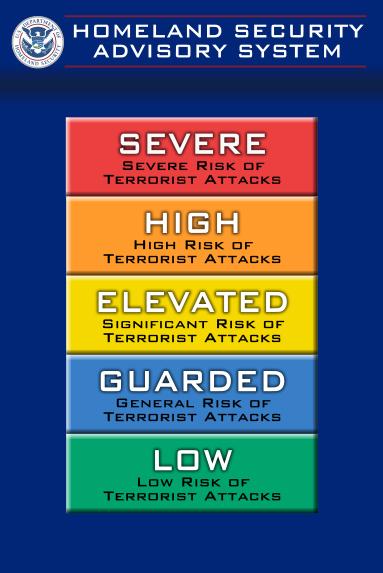New terror alert system focuses on informing, not scaring

The old color-coded threat level system will be replaced.
In a move that could make George W. Bush a bit blue, the Department of Homeland Security recently announced the elimination of the color-coded xylophone terror alert system in favor of a new, “more descriptive and preparatory” replacement.
The National Terrorism Advisory System, which goes into effect on April 27, will have only two alert levels: an “imminent threat” and an “elevated threat.” A draft of the proposal for the new system wanted to “replace a system that communicates nothing with a system that communicates precise, actionable information based on the latest intelligence.” Orange you glad to hear that?
The outgoing model, known officially as the Homeland Security Advisory System was, according to the department, designed in the aftermath of Sept. 11, 2001, to provide “a comprehensive and effective means to disseminate information regarding the risk of terrorist acts to federal, state and local authorities and to the American people.” But that sly pledge to disseminate information was instead replaced by a program that sporadically blurted colors decided by rotating power sources: Vice President Dick Cheney and Secretary of Defense Rumsfeld, along with Directors of Homeland Security Tom Ridge and Michael Chertoff. This was theoretically in correspondence with clear and present terror threats on American soil or, as some believe, with the Bush administration’s political need.
Despite its good intentions of informing, protecting and limiting loss of life in a terrorist emergency, the previous system was asinine, especially with the Bush Administration’s frequent unwillingness to explain threat level changes. The Rasmussen National Telephone Survey of likely voters found that 53 percent favor the decision to abandon the color-coded threat warning system. Only 17 percent thought that the warnings helped make America safer from terrorism.
Was the old system just a gimmick Uncle Sam used to manipulate us? “The old color-coded system taught Americans to be scared, not prepared,” said Rep. Bennie Thompson, D-Mo. “Each and every time the threat level was raised, very rarely did the public know the reason, how to proceed, or for how long to be on alert.”
A disclaimer reading “Raising the threat condition has economic, physical and psychological effects on the nation,” was once branded on the Department of Homeland Security’s website like the cancer warnings slapped on packs of cigarettes.
Though the color-coded scale looked more like a toddler’s toy than a system for disseminating critical information, it should serve as a reminder that the White House should not be used as a political playground. However, simple-minded and confusing the alert system may seem to us now, it had a frightening effect from 2002 to 2005 when alerts would be bumped up to orange (HIGH!) or red (SEVERE!)
Rep. Peter King, R-N.Y., chairman of the House Committee on Homeland Security, saw the writing on the wall: “Though the system served a valuable purpose in the terrible days and months following the terrorist attacks of Sept. 11, it was clearly time for the current color-coded system to be replaced with a more targeted system. I know they have been working on this for a long time. It sounds to me like the changes they are proposing make sense.”
An unexplained increase to an orange threat level will probably do little to save us. In an age when terrorism dominates cable news and our nation has been on guard for a full nine years, it seems we have figured things out with the alert system. Finally, the majority of Americans can move on from that swatch of Candy Land terrain that assesses our risk of being blown up and instead receive vital information concerning the security of our nation.






